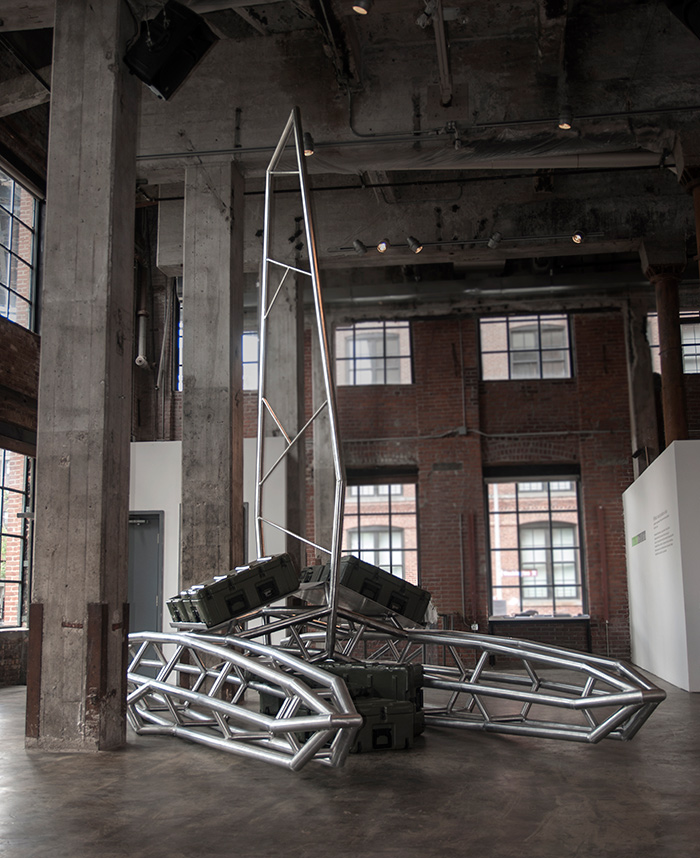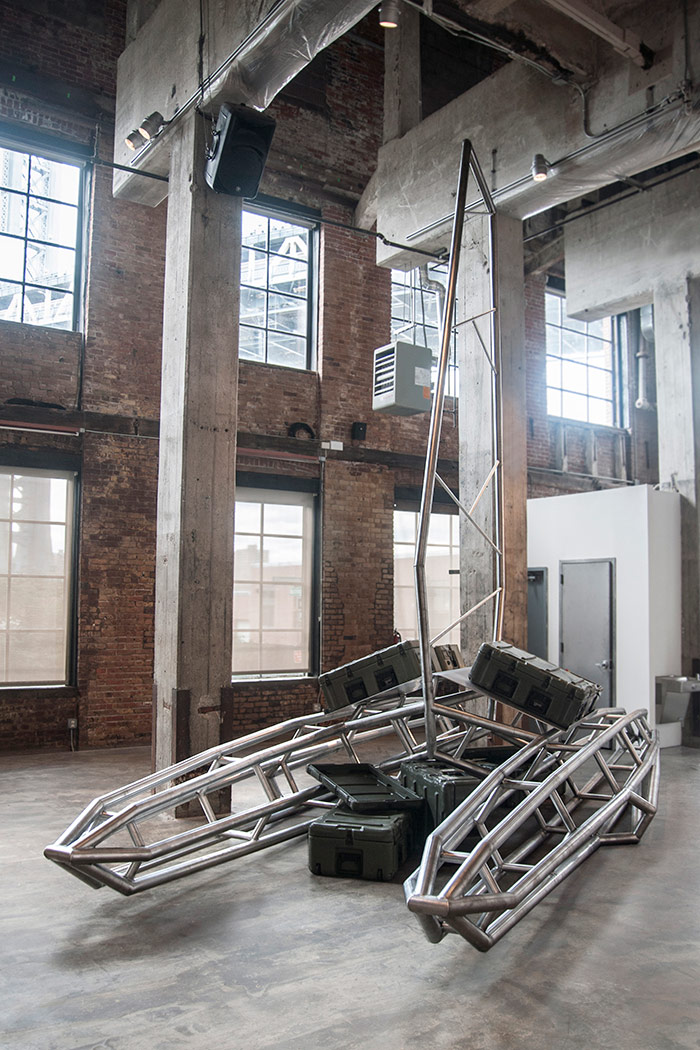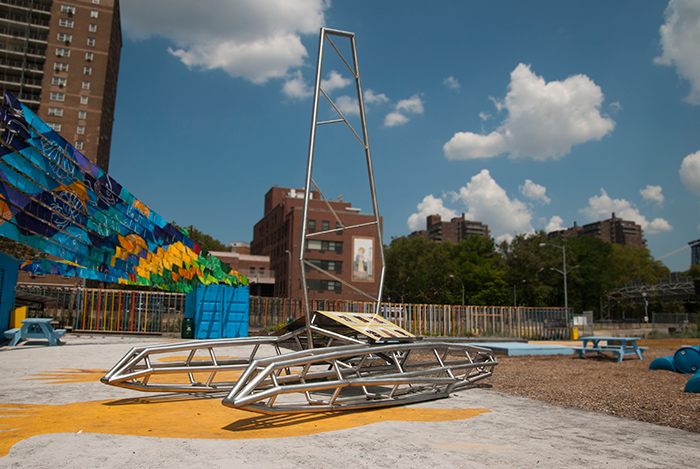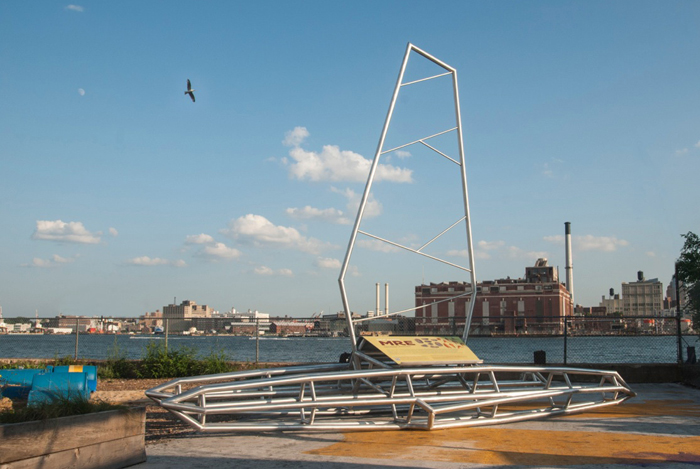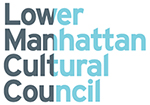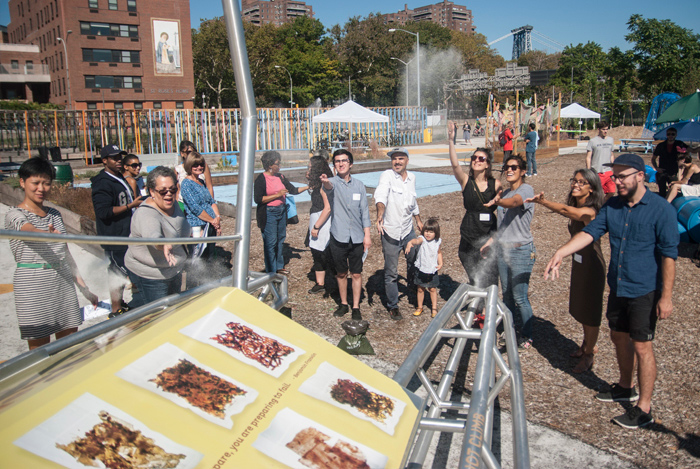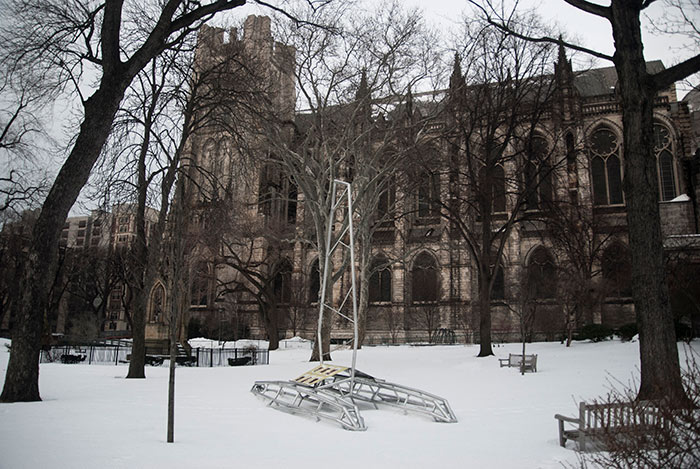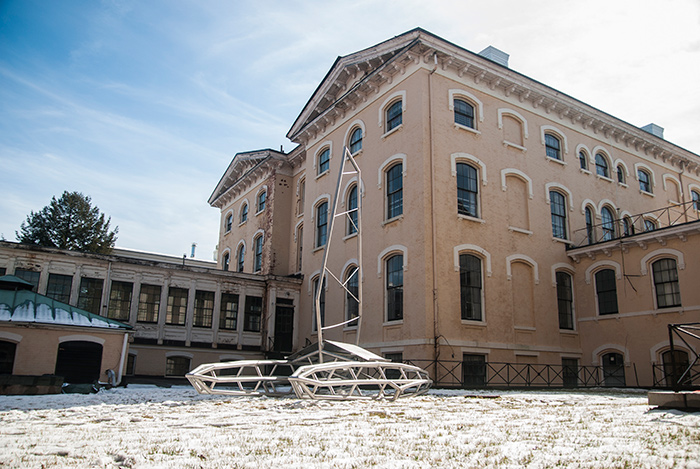NEAKA (New Earth Apocalypse Knowledge Advancement) unit is a metal keyframe catamaran that is a vitrine for NEMRE. The vessel is a symbolic reminder of an uncertain future due to societal collapse (population, climate, water, agriculture and energy) and a call to action in preparation to face such a challenge.
NEAKA (New Earth Apocalypse Knowledge Advancement) unit, 2014, 22ft long x 10ft wide x 18 ft high, break apart to 5 components. Design team: AWARE/Andrew Weigand Fabrication: Martin Alfero and Luis E. Rico for Iron Work Alfatech
Understanding traditional knowledge in The biggest problem climate change poses isn’t how to plan for resource wars, or how we strength of sea wall, or when we should evacuate. It won’t be addressed by buying an electric car, signing a treaty, or turning off the air-conditioning. The biggest problem we face is a philosophical one: understanding that this civilization is already dead. The sooner we confront this problem, and the sooner we realize there’s nothing we can do to save ourselves, the sooner we can get down to the hard work of adapting, with mortal humility, to our new reality. If we want to learn to live in the Anthropocene, we must first learn how to die. An 18th-century Samurai manual, Yamamoto Tsunetomo’s “Hagakure,” which commanded: “Meditation on inevitable death should be performed daily.” Instead of fearing my end, I owned it. “If by setting one’s heart right every morning and evening, one is able to live as though his body were already dead,” wrote Tsunetomo, “he gains freedom in the Way.” A vitrine for NEMRE Dehydration and food preservation technic had been employed by seafarer to enable them to explore the vast ocean. To survive, ancient man had to harness nature. In frozen climates he froze seal meat on the ice. In tropical climates he dried foods in the sun. Food by its nature begins to spoil the moment it is harvested. In ancient times the sun and wind would have naturally dried foods. Evidence shows that Middle East and oriental cultures actively dried foods as early as 12,000 B.C. in the hot sun. Later cultures left more evidence and each would have methods and materials to preserve their food supplies—fish, wild game, domestic animals, etc. Vegetables and fruits were also dried from the earliest times. The Romans were particularly fond of any dried fruit they could make. In the Middle Ages, they purposely built “still houses” to dry fruits, vegetables and herbs in areas that did not have enough strong sunlight for drying. A fire was used to create the heat needed to dry foods and in some cases Symbol of a vessel A vessel is a symbol of spiritual journey, the shape of the vessel is to work with nature, harvest it energy, not against it. It slit through the sea, it capture the wind, it displace the water in order to achieve buoyancy. Embarking on an expedition is to engage the unknown, one moment is perfect stillness and the next a perfect storm. As seafarers all we can do is to stay a float, to survive and surrender to the force at work a perfect metaphor of how to navigate life. In some cultures, a vessel are the carriers of the soul and voyages are often portrayed as allegories of a journey through life – or a crossing from the realm of the living to that of the dead. Human survival also closely connected with boat, we can escape the vastness of land by boat and escape danger from animal and enemy territory and hard terrain. We establish new civilization or escape an oppress authority by boat. A vessel is a mode for commerce and refuge and a symbol of hope for a better life. Nautical inspiration Catamaran was derived from Tamil word Kattumaram, literally ‘tied wood’. There are three terms that describe the components of multihulls. The term vaka, like the related terms aka and ama, come from the Malay and Micronesian language group terms for parts of the outrigger canoe, and vaka can be roughly translated as canoe or main hull. Vessel terminology Ama – The term ama comes from the proa. The vaka is the main hull, the ama is the outrigger, and the aka or iako (Hawaiian) is the support connecting the two (not three) hulls. The term ama and aka have been widely applied to modern trimarans. Vaka – A proa consists of a vaka, the main canoe-like hull; an ama, the outrigger; and akas, the poles connecting the ama to the vaka. Catamarans and trimarans share the same terminology, with a vakan, ama, and aka.
FOODshed: Art and Agriculture in Action Smack Mellon, 92 Plymouth Street, Brooklyn, NY 11201 Artists: Joan Bankemper/Black Meadow Barn; EcoArtTech- Leila Nadir + Cary Peppermint; Joy Garnett; Habitat For Artists Collective (Simon Draper, Michael Asbill, Carmen Acuna, Dan McGinley, Brandon Cruz, Jessica Poser); Natalie Jeremijenko; Kristyna and Marek Milde; Peter Nadin/Old Field Farm; Andrea Reynosa, Brooklyn Grange and Alloy; Bonnie Ora Sherk; Jenna Spevack, Susan Leibovitz Steinman/Mona Talbott; Elaine Tin Nyo; Tattfoo Tan, Linda Weintraub Exhibition Dates: June 7 to July 27, 2014
FOODshed: Agriculture and Art in Action focuses on sustainable agriculture, entrepreneurship, and artists' use of food as subject matter or medium. The exhibition and programming include 14 exhibiting artists in the gallery at Smack Mellon, 3 public projects in the nearby DUMBO community, as well as public workshops in collaboration with the artists in the exhibition. The gallery exhibition features artworks and inventive projects around agriculture and food that address farming as both activism and art form. Many of the artists in this exhibition are known for bringing community-specific issues into their work and are exploring the real-world implications of small-scale farming and raising community awareness about our food systems. Their varied practices include growing food, cooking food, raising animals for food, and engaging communities about local food production as well as instigating new artist-based economies. The artists working in New York State today in the realm of food and farming coincide with a larger cultural awakening regarding the ills of our present system, such as the distances food travels to supermarket shelves and the effects of shipping and transport on climate change. Brooklyn has become the epicenter for food activism and culinary explorations. Artists have joined food activists in focusing on environmental problems such as lack of biodiversity in mono-cultural farms, the loss of top soil and nutrient-poor soil, the abuse and poor conditions of feedlot and factory raised animals, the conversion of farmland into housing, and the waste of un-harvested crops. Artists are now farming, not only to raise their own food in order to become self-reliant and to eat more healthily, but also to offer alternative and sustainable approaches within their local communities. For the artists in FOODshed, the acts of cultivation, growing, and by implication educating have evolved to a deeper level of activism where the boundaries of real world and art completely disappear. Their projects present new paradigms regarding the growing, production, distribution and consumption of food. The artists in this exhibition advocate for an organic, regional and local approach, which they are manifesting in their own lives.
NEAKA (New Earth Apocalypse Knowledge Advancement) Unit by artist Tattfoo Tan at Squib Bridge Park/Brooklyn Bridge Park is an aluminum structure in the form of a catamaran. It acts as a symbol for a post-economic meltdown, global warming and Tan’s ongoing social practice project- NEMRE (New Earth Meal-Ready-to-Eat) a dehydrated meal harvested from food waste. Through this project the artist inspires others to practice this ancient food preservation technique. Dehydration of food can help prepare for future disaster as well as provide nutritious meals, knowing every ingredient and wasting none. The artist will lead a workshop on food dehydration at Smack Mellon. John Street Pasture is a temporary living earthwork that celebrates green space, agriculture, and the transitional nature of urban land. A planted cover crop of crimson clover will bloom into a lush field of reds and greens all while creating a nutrient rich resource of nitrogenized soil for the now under-construction John Street section of Brooklyn Bridge Park. John Street Pasture is located at 1 John Street and is a collaboration of Andrea Reynosa, Brooklyn Grange and Alloy. Brooklyn-based artist team Kristyna and Marek Milde will present À la cart, a 2-part project at Smack Mellon and at the Pearl Street Triangle in DUMBO. À la cart, a temporary vegetable garden, uses shopping carts, soil and plants, to create a participatory, edible workshop experiment. The gallery serves as a base for the project, “a garden shack”, presentation platform and hub for gathering and talks on food and sustainability. The Mildes invited members of the DUMBO community to join the project and grow ingredients in the shopping carts for a single dish. The participants are tending, watering, harvesting and later cooking the vegetables, to actively experience the process of growing food instead of shopping for it. Hudson Valley based artists collective Habitat for Artists will be installing Mic-GRO, one of its signature, temporary, reusable art studios. The studio will be transformed into a growing shed for edible greens and seed propagation, partnering with organizations including the Hudson Valley Seed Library, Obercreek Farm CSA based in Hughsonville, NY and Green Up, a business supporting the design of plant-based systems that showcase the environmental benefits of green technology based in Stamford, CT. Bonnie Ora Sherk, a pioneering ecological artist founded Life Frames, Inc. (LFI) and The Farm in San Francisco in 1974. The Farm led the transformation of 7-acres of derelict land fragments into a vital and bucolic environmental and agricultural community education center replete with agro-ecology gardens, farm animals, multi-arts programs, and a new City park. Beginning in 1981, the Life Frame evolved to become, A Living Library (A.L.L.) a powerful framework, planning tool, and series of strategies and methodologies that incorporates local resources: human, ecological, economic, historic, technological, and aesthetic. Sherk will exhibit a series of drawings and video projections from her project Roosevelt Island Living Library & Think Park for Southpoint, 2003 – present. Natalie Jeremijenko, artist/engineer and professor/director of the NYU xDesign Environmental Health Clinic will present the Manufactory: FlowerFLOSS (Free Libre Open Source Systems) and xCola event. This performance event explores open-systems food production. A group of teens will spin FlowerFLOSS, serve xCola, and sing while assisting in the assembly of these bird, bee, and butterfly-friendly snacks. Video installation will accompany the on-site Manufactory to project Natalie Jeremijenko's own explanation of the experiment. Ecoarttech is a collaborative art project by Rochester NY artists, Leila Nadir + Cary Peppermint. They will present OS Fermentation: Collaborative Hacks with Fruits, Vegetables, and Microbes. Fermentation is a practice being lost in the industrial food system, which has positioned eaters as passive consumers rather than creative participants. Nadir and Peppermint will present an OS Fermentation Workshop, a slow-cooking class, a healing ritual, and a collaboration with bacteria. Joy Garnett will exhibit Piss & Vinegar (art and ferment), anartisanal red wine vinegar fermented in small batches by hand in Greenpoint, Brooklyn. An installation of artworks and foodworks reflect the pioneering DIY industriousness of the artist’s maternal grandfather: Egyptian poet and beekeeper Dr. Ahmed Zaky Abushady.
Public Workshops Kale Chip Worksop with artist Tattfoo Tan Dehydrated food is consider raw and contains most of its nutrients. The problems of climate change and food waste are new, but the solutions don’t have to be. People have been eating bruised vegetables and using techniques like dehydration and fermentation for centuries. Sometimes in order to move forward, we have to look back and relearn what we have lost. We can use this knowledge and these techniques as bearings to find a more sustainable path instead of wasting our natural resources and destroying the earth.- Tattfoo Tan
This exhibition is supported, in part, by public funds from the New York City Department of Cultural Affairs, in partnership with the City Council, New York City Council Member Stephen Levin, and the New York State Council on the Arts with the support of Governor Andrew Cuomo and the New York State Legislature, and with generous support from The Andy Warhol Foundation for the Visual Arts and Smack Mellon’s Members. John Street Pasture is made possible with support from Alloy and Brooklyn Bridge Park. We extend a special thanks to Brooklyn Bridge Park, New York City Department of Parks and Recreation and The DUMBO Improvement District for their support for FOODshed public projects.
LMCC's Arts East River Waterfront initiative, including the partnership on Pier 42, provides an opportunity for residents and local artists and community organizations to connect and imagine potential future uses of public space along the waterfront. LMCC empowers artists by providing networks, resources, and support, to create vibrant, sustainable communities in Lower Manhattan and beyond. Path to Pier 42 is located along the East River between the Manhattan and Williamsburg Bridges. The temporary park site is on the south side of the FDR Drive with entrances from the East River Greenway at Montgomery Street and through Corlears Hook Park at Cherry Street. The nearest subway station is the F train at East Broadway. Click here to access Google Map.
Cheristening of NEAKA on September 27, 2014 at Pier 42
References: NASA study concludes when civilization will end, and it's not looking good for us. Fast Company: A Catamaran Carrying Dried Food For The End of Times The Making of Paths to Pier 42: An Interview with Tattfoo Tan
|
